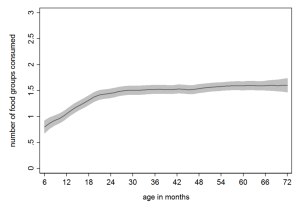Improving children’s diets is intrinsically valuable, not only to improve their wellbeing but because healthy diets lead to well-nourished and healthy children, who in turn become healthy and economically productive adults. Moreover, there is growing evidence that the quality of children’s diets – specifically the consumption of nutrient rich legumes and animal source foods as well as vitamin-rich fruits and vegetables – is as important as the quantity of calories consumed.
In developed countries, two sets of interventions have been adopted to improve children’s diet in countries – these are income and in-kind transfers, and nutrition education. These approaches assume that households have a good access to food markets so that production and consumption decisions do not depend on each other. But in Ethiopia, and many other developing countries, such separability of consumption and production may not hold. If markets are not integrated, own food production will affect what foods are available for consumption.
Food diversity and diet
This research explores the relationship between the diversity of household agricultural production and the diversity of pre-school children’s food consumption in rural Ethiopia. Across the country, the climatic conditions enable an enormous variety of foods to be grown. However, the rugged terrain and poor infrastructure mean that access to non-staple foods, such as dairy products, varies widely. For an average household, the distance to the nearest food market is more than 10 kilometers. Most children eat a monotonous, undiversified diet (Figure 1).
Notes: The shaded area represents the 95%-confidence interval
Source: Feed the Future Survey 2013
Survey data
The study analyzes cross-sectional survey data collected between June and July 2013 from 5 regions in Ethiopia – Amhara, Oromiya, SNNPR, Somali and Tigray. The survey was designed to serve as a pre-intervention (baseline) study to measure the impact of the USAID’s Feed the Future Investments in Ethiopia. The sample is very large (7,011 households) and widespread (252 villages in 84 woredas) with 4,214 children aged 6-71 months in this sample. The survey included data on children’s food consumption based on a 1 day re-call and rich information about households’ agricultural production over the past 12 months.
The results show that children’s diets strongly depend on households’ production choices. This relationship is particularly strong for households with limited access to food markets, but does not hold for households that do have good access to markets where they can buy and sell food products.
Conclusions and implications
In Ethiopia, it is not just a simple matter of encouraging households to diversify their produce – the limiting agro-climatic conditions and poor market access are major constraints. Rather, the results suggest that agricultural interventions that encourage increased productivity, together with deepening market integration in remote areas to increase availability of food products that are not easily available, as well as behavior change communication to support learning about why it is important to feed children a diverse diet, are more likely to result in improved pre-school diets and nutritional status. But further work though more rigorous evaluation of interventions and the influence of accessible markets on nutrition, is needed to confirm the robustness in these ideas.
To read more about this research, please refer to ESSP Working Paper 69. You may also subscribe to regular updates on ESSP’s work and its quarterly newsletter.
An earlier presentation on this topic was organized by ESSP with support from EDRI. ESSP is a collaborative program undertaken by IFPRI and EDRI, whose objective is to help improve the policy-making decision process in Ethiopia.

